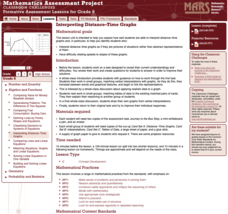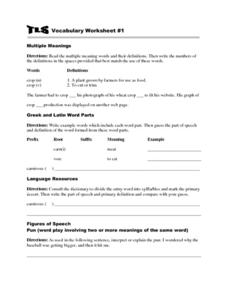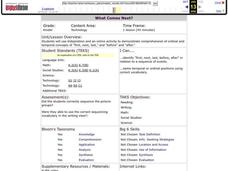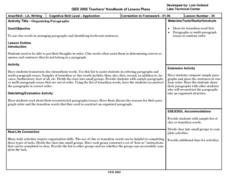K5 Learning
Dessert Time!
First do this and then do that. Next do this and after do that. Young readers read about the order each person in the story gets dessert, before answering the who, the what, and the how in the reading passage.
Mathematics Assessment Project
Interpreting Distance–Time Graphs
Pre-algebra protégés critique a graph depicting Tom's trip to the bus stop. They work together to match descriptive cards to distance-time graph cards and data table cards, all of which are provided for you so you can make copies for...
Curated OER
Sequence, Predict, Infer: Pink and Say
Practice sequencing with your 2nd graders via Patricia Polacco's Civil War book Pink and Say. Begin with a blindfold and a bag of mystery items. Connect their use of clues to identify what they can't see with the skill of making...
Curated OER
The Use of Signal Words in Writing
Students examine the use of transition or signal word to create good paragraph organization.
Pennington Publishing
Vocabulary Worksheet #1 & #2
These two worksheets cover several grammatical topics. Pupils work on words with multiple meanings, Greek and Latin word parts, word connotations, academic language, and more. The result is seven quick exercises that could be used...
Curated OER
What Comes Next?
Students use Kidspiration and on online activity to demonstrate comprehension of ordinal and temporal concepts of "first, next, last," and "before" and "after." They name temporal or ordinal positions using correct vocabulary.
Curated OER
Organizing Paragraphs
High schoolers brainstorm transition words, and utilize word list to order paragraphs and multi-paragraph essays.
Curated OER
A Course in Basic Skills
Tenth graders complete a course in basic skills in order to meet the standards for sophomore year. Using one of their classmates papers, they identify the main idea, topic sentence and theme. They also identify the transitional words...
Virginia Department of Education
Maintaining Organization, Clarity, Central Idea, and Unity
Introduce and challenge the essay organization skills of your junior high writers with the paper reconstruction activity in this demonstration. Theydetermine what the word organization means, and discover the basic organizational...
Beth Kupper-Herr
Taking Notes
When you ask your students to take notes during class, do they really know what you mean? Are they taking the right kind of notes and using their time effectively? Make sure they are by offering this handout, a comprehensive guide...
Curated OER
Vocabulary and Language Development
Young scholars discover new vocabulary words. In this language development instructional activity, students reach into a box of themed items and identify the object. They discuss the attributes of the object as well.
Curated OER
The Language of Mathematics
Learners integrate the language, concepts and skills of math into the daily routine and classroom environment. They think mathematically by participating in short, daily, individual, small group, whole group and transitional activities...
Portland Public Schools
Opinion: Persuasive Essay Unit Introduction
Opinion, audience, purpose. Fourth graders are introduced to the three characteristics of persuasive writing in the third unit of a year-long writing program. The 98-page packet is complete with plans, model essays, graphic organizers,...
Curated OER
Wacky Web Tales
Students study the parts of speech and then review them. They identify each part of speech and place them on a tree map. Then they visit a website to create a "Wacky Web Tale" using information from the tree map. They print their tales...
Curated OER
The New Texas Two-Step
Sixth graders work with mathematical expressions by interpreting, analyzing and problem solving with them. For this two step algebraic problem solving lesson, 6th graders use algebra tiles to solve equations.
Curated OER
Counting Principle
Students identify the different outcomes given a situation. For this algebra lesson, students calculate the possible outcome using the counting principle. They compare and analyze patterns to make their predictions.















